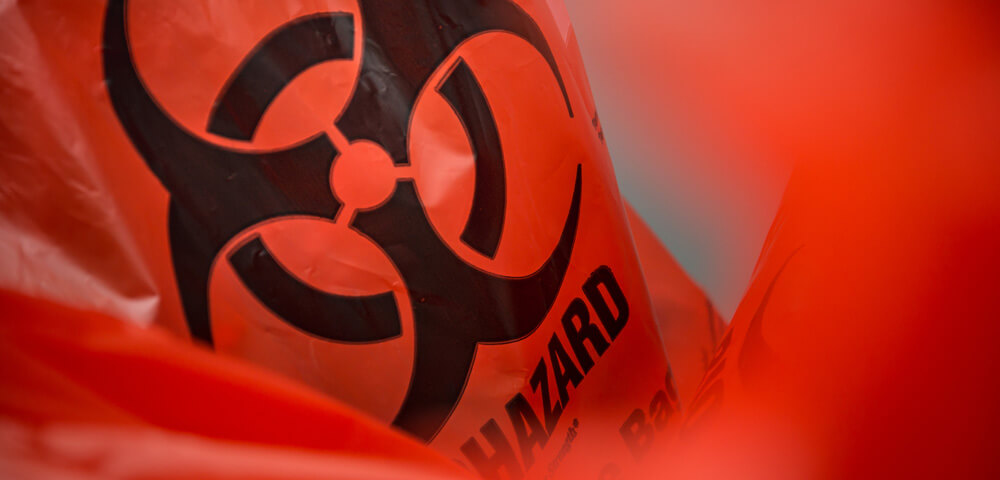
/ IN THIS BLOG
01 / What kinds of medical facilities require regulated medical waste disposal?
Does your facility generate a regulated medical waste? If you’re unsure—and you’ve found your way to this blog—then the possibility has at least crossed your mind; and you have a legal need to know.
To begin, substances that are considered regulated medical waste don’t always come from where people usually imagine: hospitals and clinics with harried doctors and nurses busily wielding cotton swabs and hypodermic needles.
Instead, there are many regulated medical waste generators that are less obvious to the casual observer, but nonetheless in the crosshairs of regulatory agencies. Drug stores, dental offices, and funeral homes come to mind. So do:
Blood banks
Doctor offices
Healthcare facilities
Hospices
Laboratories
Long-term care facilities
If your enterprise is one of these, then it’s likely you’re in need of some level of regulated medical waste disposal.
02 / What is considered a regulated medical waste?
There’s no universally accepted definition for regulated medical waste. It varies from country to country. In the US, it even varies from state to state. Logically, it’s the infectious or otherwise dangerous detritus of medical procedures, surgeries, biopsies, and what-have-you.
Culprits are needles, scalpels, and other sharps. So are used swabs, bandages, and gauzes, along with disposable gloves, aprons, and gowns. Ditto for human or animal tissues, fluids, and cultures—which, by the way, are additionally classified as pathological wastes.
There’s more; and it gets complicated. So as in all things involving medical waste management, it’s crucial to get expert advice. Meanwhile, read on:
03 / How are regulated medical wastes categorized?
In general, there are six categories of regulated medical waste. And in the U.S., each has its own state-specific handling requirements. The categories are:
Pathological wastes. E.g. tissues, organs, body parts, and body fluids removed during surgery and autopsy. Also, see Contaminated animal wastes.
Contaminated animal wastes. Actually, a subcategory of Pathological wastes, but with its own waste-stream designation, these include carcasses, body parts, and bedding from animals intentionally exposed to pathogens in research, biologicals production, or drug tests.
Human blood and blood products. E.g. waste blood, serum, plasma, and blood products
Microbiological wastes. Cultures and stocks of infectious agents such as laboratory specimens (E.g. culture dishes; transfer, inoculation, and/or mixing devices; discarded live and attenuated vaccines; etc.)
Contaminated sharps. E.g. contaminated hypodermic needles, syringes, scalpel blades, pipettes, and broken glass
Isolation waste. Wastes generated from patients who are isolated to protect others from a communicable disease
04 / Generally, who regulates medical waste?
As most rules are defined & enforced at the state level, regulated medical waste presents a number of compliance challenges, especially since guidelines for medical waste disposal are often issued from more than one regulatory body.
Nearly all states have enacted requirements for regulated medical waste disposal, but standards vary widely. Some states have fashioned their medical waste disposal rules ala the Medical Waste Tracking Act, while others not so much.
In most states, the EPA is primarily responsible for regulated medical waste management and disposal. However, in some states, the department of health might be significantly involved (e.g., MO, OK) or even serve as the primary regulatory agency (e.g., CO).
In states where both agencies have oversight of regulated medical waste management, typically the department of health is responsible for onsite management, and the EPA monitors transportation and disposal (e.g., LA, MO).”
You can get expert advice about your particular state and locality here.
05 / Specifically, what agencies regulate medical waste disposal?
At least four federal agencies have an interest in medical waste disposal rules:
OSHA. Regulated medical waste is an occupational as well as an environmental safety concern. OSHA guidelines supersede state & local ones if the latter are less strict.
DOT. Regulated medical waste is considered hazmat, consequently subjecting its transportation to applicable DOT rules.
Medical waste disposal methods must meet CDC guidelines for infection control.
Companies claiming they have products that can reduce medical waste infectiousness must register them with the EPA’s Office of Prevention, Pesticide, and Toxic Substances—Antimicrobial Division.
06 / Do you need a comprehensive medical-waste disposal provider?
Medical waste must be made non-infectious before it can be disposed of as solid waste. There are basically two treatment technologies for this: heat and chemicals.
The waste is exposed to high-temperatures in a steam autoclave. Other methods involve dry-heat systems, specialized microwave ovens, or plasma-arc technology.
Chlorine compounds, ozone, alkalis, or other disinfectants such as peracetic acid or glutaraldehyde can be used for small amounts of regulated medical waste.
Such onsite processes are the domain of large hospitals and facilities that have substantial dedicated resources. The required equipment is pricy to buy, maintain, manage, and operate—and closely regulated by government.
Thus, you’re going to have to transport any regulated medical waste offsite to a medical waste‑management treatment facility. This will require access to both a transporter and a treatment company, each licensed or “permitted” to handle regulated medical waste.
Given the strictness and complications surrounding regulated medical waste, it’s advisable to seek a comprehensive provider for regulated medical waste disposal, i.e. one that won’t broker or subcontract any portion of your disposal process to another company, but instead manages the process from start to finish on your behalf.
Brokering or subcontracting across more than one company invites lapses in compliance—inadvertent or otherwise. Contrarily, a comprehensive provider manages all aspects of your regulated medical waste disposal, including container supply, transportation, disposal, compliance, and documentation, all of which greatly reduces the chances of accidental noncompliance.
Where to find a biohazardous waste company near me? Look no further than MCF, we handle every aspect of medical waste transport, documentation and disposal, protecting the compliance risk of hundreds of small to medium sized healthcare practices across the US.
07 / The upshot
As we have counseled before: The Resource Conservation and Recovery Act (RCRA) stipulates that any entity that generates a medical waste is legally responsible for it—from the metaphorical “cradle-to-grave.”
This includes not only its onsite medical waste management, but also its subsequent transportation to a properly “permitted” or licensed offsite storage, treatment, or disposal facility.
In other words, once you’ve generated a medical waste, there’s no way to rid yourself of complete legal responsibility for it. That said:
Regulated medical wastes require meticulous and qualified management. There’s container supply, transportation, disposal, compliance, documentation, and more. All of this can be a huge distraction from your existential purpose: curing people (or their beloved animals) and keeping them well.
Don’t go there. Go here, instead. And get honest, expert advice from folks who’ve been in the business for over three decades.
Thank you for reading our blog!
Robert Losurdo
President, COO








